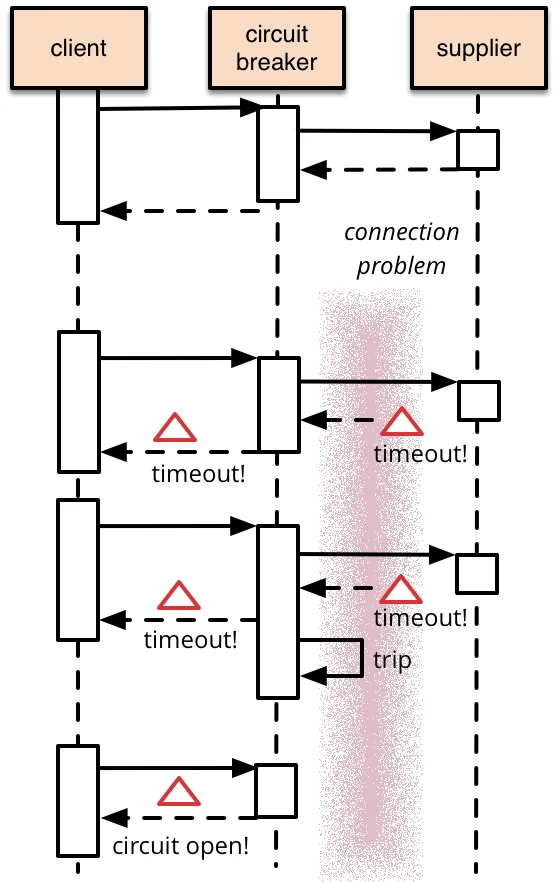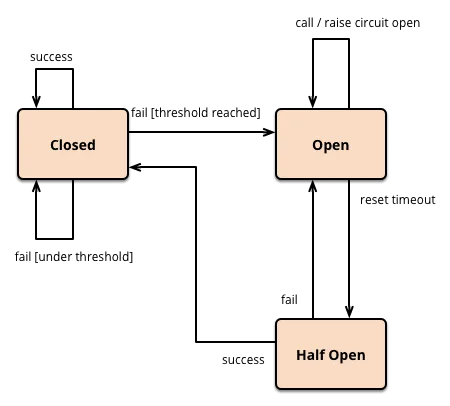一些场景下,为了保障服务稳定性会引入熔断机制。本文介绍了用 Go 语言自己实现熔断需要什么操作。

什么是熔断?
熔断是指在下游发生错误时上游主动关闭或限制对下游的请求。

原理
- 通常熔断器分为三个时期:CLOSED,OPEN,HALFOPEN
- RPC 正常时,为 CLOSED;
- 当 RPC 错误增多时,熔断器会被触发,进入 OPEN;
- OPEN 后经过一定的冷却时间,熔断器变为 HALFOPEN;
- HALFOPEN 时会对下游进行一些有策略的访问,然后根据结果决定是变为 CLOSED,还是 OPEN;
总得来说三个状态的转换大致如下图:

Go 实现
IsAllowed 是否允许请求,根据当前状态判断
CLOSE 允许
OPEN
- 在 CoolingTimeout 冷却时间内,不允许
- 过了冷却时间,状态变为 HALFOPEN,允许访问
HALFOPEN
- 在 DetectTimeout 检测时间内,允许访问
- 否则不允许
atomic.StoreInt32((*int32)(&b.state), int32(HALFOPEN))
trip 判断是否达到熔断限额(可以自定义)
- type TripFunc func(Metricser) bool
- ThresholdTripFunc 错误阈值
- ConsecutiveTripFunc 连续错误超过阈值
- RateTripFunc 根据最少访问数和错误率判断
Metricser 访问统计,包括成功数、失败数、超时数、错误率、采样数、连续错误数
- type Metricser interface {
- Fail() // records a failure
- Succeed() // records a success
- Timeout() // records a timeout
- Failures() int64 // return the number of failures
- Successes() int64 // return the number of successes
- Timeouts() int64 // return the number of timeouts
- ConseErrors() int64 // return the consecutive errors recently
- ErrorRate() float64 // rate = (timeouts + failures) / (timeouts + failures + successes)
- Samples() int64 // (timeouts + failures + successes)
- Counts() (successes, failures, timeouts int64)
- Reset()
- }
window 实现类
- type window struct {
- sync.RWMutex
- oldest int32 // oldest bucket index
- latest int32 // latest bucket index
- buckets []bucket // buckets this window holds
- bucketTime time.Duration // time each bucket holds
- bucketNums int32 // the numbe of buckets
- inWindow int32 // the number of buckets in the window
- allSuccess int64
- allFailure int64
- allTimeout int64
- conseErr int64
- }
- type bucket struct {
- failure int64
- success int64
- timeout int64
- }
用环形队列实现动态统计。把一个连续的时间切成多个小份,每一个 bucket 保存 BucketTime 的统计数据,BucketTime * BucketNums 是统计的时间区间。
每 BucketTime,会有一个 bucket 过期
- if w.inWindow == w.bucketNums {
- // the lastest covered the oldest(latest == oldest)
- oldBucket := &w.buckets[w.oldest]
- atomic.AddInt64(&w.allSuccess, -oldBucket.Successes())
- atomic.AddInt64(&w.allFailure, -oldBucket.Failures())
- atomic.AddInt64(&w.allTimeout, -oldBucket.Timeouts())
- w.oldest++
- if w.oldest >= w.bucketNums {
- w.oldest = 0
- }
- } else {
- w.inWindow++
- }
- w.latest++
- if w.latest >= w.bucketNums {
- w.latest = 0
- }
- (&w.buckets[w.latest]).Reset()
Panel Metricser 的容器
PanelStateChangeHandler 熔断事件
- type PanelStateChangeHandler func(key string, oldState, newState State, m Metricser)
缺陷
- 所有 breaker 公用同一个 BucketTime,统计周期不支持更新
- 冷却时间不支持动态更新
